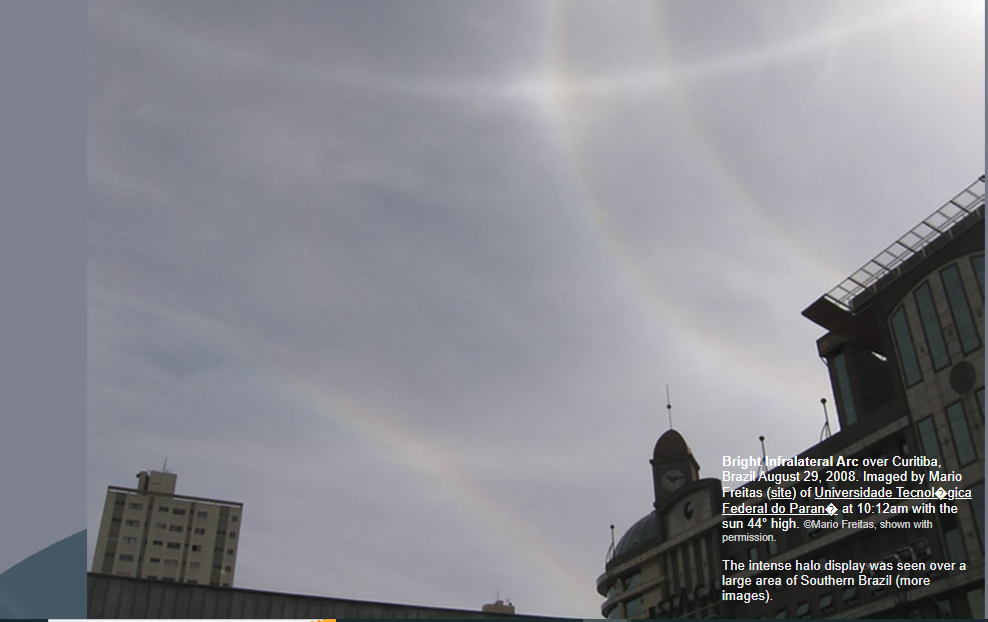Brazil Infralateral Arc
Exploring the Phenomenon of the Brazil Infralateral Arc
Atmospheric optics never ceases to amaze with its captivating displays of light and color. One such intriguing phenomenon is the Brazil Infralateral Arc. This rare optical event was witnessed over a large area of Southern Brazil, leaving observers in awe of its beauty and complexity.
The Brazil Infralateral Arc is characterized by a bright arc with widely separated colors at the lower left side of the image. It is formed by singly oriented column crystals, which are the same crystals responsible for generating the more common circumscribed halo. These column crystals have prism side faces inclined at 60 degrees to one another, allowing rays to pass through and create the circumscribed halo. However, for the infralateral arc, rays enter through a near-vertical hexagonal end (basal) face and exit through a side face inclined at 90 degrees. This greater angle disperses the halo colors more widely, resulting in the distinctive appearance of the infralateral arc.
The rarity of infralateral arcs can be attributed to several factors. Firstly, the end faces of column crystals often exhibit deformations and indentations, making it less likely for rays to pass through or be reflected from them. Consequently, halos associated with these deformed end faces, including infralateral arcs, supralateral arcs, 46° halos, and Wegener arcs (collectively known as 46° arcs), are less commonly observed compared to halos passing through the usually more perfect crystal side faces.
Another contributing factor to the rarity of infralateral arcs is their wider angular extent compared to 22° arcs. As a result, the light from the infralateral arc is spread over a greater area of the sky, making it more challenging to observe.
In addition to the bright infralateral arc, Mario's image also captures a white streak crossing the arc, possibly indicating the presence of a rare lower Wegener arc. The Wegener arc is another atmospheric optical phenomenon that occurs when light passes through horizontally oriented ice crystals. Its lower counterpart, the lower Wegener arc, is less commonly seen and adds to the uniqueness of this particular observation.
To further understand the characteristics of the Brazil Infralateral Arc, a HaloSim ray tracing simulation was conducted. The simulation, using a fisheye projection, closely resembled the observed arc in Mario's image. This alignment between observation and simulation provides valuable insights into the behavior of light within the atmosphere and helps validate our understanding of these atmospheric optical phenomena.
It is worth noting that the Brazil Infralateral Arc is not an isolated occurrence. Similar arcs have been observed in other regions, such as the Antarctic and Colorado, further highlighting the global nature of these fascinating atmospheric displays.
In conclusion, the Brazil Infralateral Arc is a captivating atmospheric optics phenomenon characterized by a bright arc with widely separated colors. Its rarity stems from the unique orientation and deformations of column crystals, as well as its wider angular extent compared to more common halos. Observations and simulations of this arc contribute to our understanding of atmospheric optics and remind us of the mesmerizing beauty that nature has to offer.

Bright Infralateral Arc over Curitiba, Brazil August 29, 2008. Imaged by Mario Freitas (site) of Universidade Tecnol�gica Federal do Paran� at 10:12am with the sun 44° high. ©Mario Freitas, shown with permission.
The intense halo display was seen over a large area of Southern Brazil (more images).
22� and circumscribed halos dominate the image but the unusual feature is the bright arc with widely separated colours at lower left - an infralateral arc.
Infralateral arcs are produced by singly oriented column crystals - the same orientation that generated the circumscribed halo. The latter results from rays that pass through two prism side faces inclined 60� to one another. Rays forming the infralateral arc instead enter a near vertical hexagonal end (basal) face and exit through a side face. These faces are inclined at 90� rather than 60� and the greater angle disperses the halo colours more widely.
Infralateral arcs are fairly rare and some of that rarity arises from their ray path. The end faces of column crystals are often deformed and indented. Halos whose rays would pass through or be reflected from them (infralateral, supralateral, 46�, Wegener - called collectively 46� arcs) are therefore rarer than ones passing only through the usually more perfect crystal side faces (circumscribed, tangent arcs, 22� halo called collectively 22� arcs).
Another factor is that the infralateral arc is wider than 22� arcs and its light is hence spread over a greater sky area.
The lower left of Mario's image has a white streak crossing the infralateral arc. This is possiblya rare lower Wegener arc.
The arc shows on the accompanying HaloSim ray tracing simulation. A fisheye projection was used and a box marks the approximate extent of Mario's image. The upper Wegener arc was seen elsewhere in Brazil and intersecting lower Wegener, infralateral and a 46° halo were imaged at �guas de Santa B�rbara-SP by Juliana Medeiros.
Antarctic infralateral arc, Colorado infralateral and supralateral arcs. More halos.

Note: this article has been automatically converted from the old site and may not appear as intended. You can find the original article here.
Reference Atmospheric Optics
If you use any of the definitions, information, or data presented on Atmospheric Optics, please copy the link or reference below to properly credit us as the reference source. Thank you!
-
<a href="https://atoptics.co.uk/blog/brazil-infralateral-arc/">Brazil Infralateral Arc </a>
-
"Brazil Infralateral Arc ". Atmospheric Optics. Accessed on November 24, 2024. https://atoptics.co.uk/blog/brazil-infralateral-arc/.
-
"Brazil Infralateral Arc ". Atmospheric Optics, https://atoptics.co.uk/blog/brazil-infralateral-arc/. Accessed 24 November, 2024
-
Brazil Infralateral Arc . Atmospheric Optics. Retrieved from https://atoptics.co.uk/blog/brazil-infralateral-arc/.